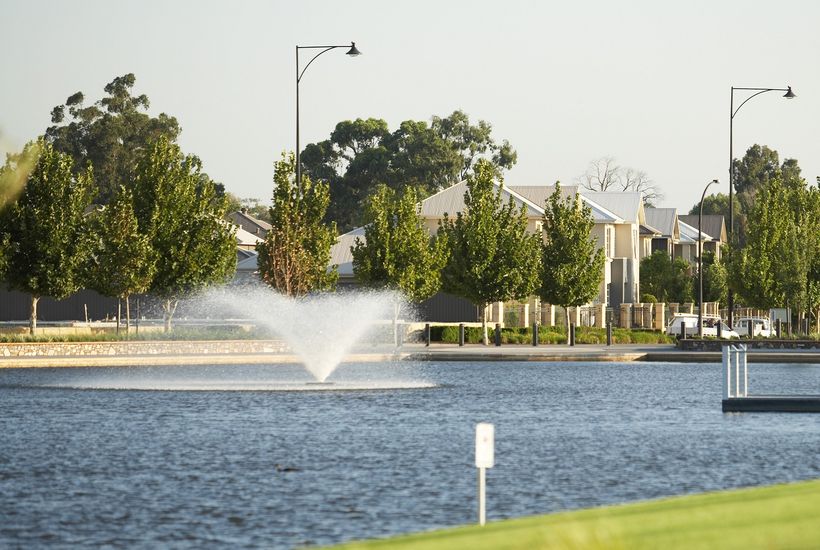Stockland sees lasting home sales boom beyond end of stimulus

Stockland, the nation’s largest residential developer, is seeing a lasting home sales surge that should push beyond the end of stimulus packages, but mortgage pressure is rising in some areas, according to credit agencies.
The lift in new home sales in February, driven by an increase of 2.4% on 2020 levels across Victoria, NSW, Queensland and Western Australia, showed that the industry has shrugged off the coronavirus crisis.
Big companies — including Stockland, which last week bought a new site in Melbourne — have been looking to speed their developments, partly to ensure buyers can qualify for government grants, but also to lock in faster development of their land banks.
While pain persists in the apartment market, new houses on the outskirts of major cities and in regional areas are selling well alongside existing stock as the preliminary auction clearance rate hit 83.2% last week, coming in slightly below last week’s preliminary figure, but on higher volumes.
Stockland Communities chief executive Andrew Whitson said the HomeBuilder stimulus “has been a powerful economic measure during the pandemic, helping to generate jobs and investment around the country”.
But the key drivers supporting demand were low interest rates, access to credit and a shift in customer preferences to lower-density living, as well as limited serviced land availability on the eastern seaboard.
Mr Whitson said these “should offset the impact of reduced net overseas migration on the masterplanned community segment”.
“The roll-off of HomeBuilder is likely to moderate second half of 2021 sales in the eastern states, but sales are expected to remain strong compared to historical averages with price growth over 2021,” Mr Whitson said.

Stockland expects sales to remain strong despite the end of HomeBuilder. Picture: realestate.com.au/buy
Industry-wide sales were up 26% on January as the market got over an initial hangover from the decrease in the level of HomeBuilder stimulus, and Victoria performed well.
Morgan Stanley analysts Simon Chan and Lauren Berry said with the second phase of HomeBuilder — a $15,000 grant — due to expire at the end of the month, they expected a rush of sales.
Building must commence within six months of contract to qualify for the second-phase grant, and they tipped that this would spur activity.
Morgan Stanley said that most sales made in January and February were unlikely to qualify for HomeBuilder. If they had qualified, they would have been either drawn forward to last December for the higher grant or been pushed back closer to this month to ensure more flexibility.
“Stockland flagged to us that only 20% of its purchasers in January/February were directly motivated by the HomeBuilder grant, suggesting that the underlying demand, assisted by low interest rates and trend towards detached homes by domestic buyers, remain robust,” Morgan Stanley said.
Meanwhile, delinquency rates for Australian residential mortgage-backed securities are predicted to increase over the first half of 2021 because of the uneven economic recovery and the end of government and lender support measures.
However, arrears rates will improve towards the end of the year as economic momentum builds, according to Moody’s Investors Service.
“In December 2020, the 30-plus days delinquency rates for prime, nonconforming and near prime Australian RMBS declined compared with that in June 2020. Coronavirus-related government support measures for individuals and small businesses and lender loan payment deferrals supported borrowers over the second half of 2020,” Moody’s vice president and senior credit officer Alena Chen said.
Moody’s forecasts Australia’s GDP growth to be 3.8% in 2021. However, the economic recovery is still uneven, with conditions improving in some sectors and remaining challenging in others.
Most lender loan payment deferral periods and some government support measures also end in March.
In this environment, the agency says mortgage delinquencies will increase over the first half of 2021, particularly when borrowers have to resume repayments after loan deferral periods end.
As of December, the share of mortgages on coronavirus-related payment deferrals averaged around 3% for prime RMBS portfolios and 4.5% for nonconforming and near prime RMBS.
“Rising house prices will curb mortgage arrears risks to some extent, because they will make it easier for borrowers in financial difficulty to sell their properties and repay loans. Towards the end of 2021, as the economic recovery gathers momentum, we expect the situation to turn around and for delinquency rates to improve,” Ms Chen said.
This article originally appeared on www.theaustralian.com.au/business/property.







